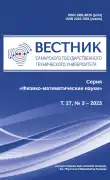Описание спектра одной операторной матрицы четвертого порядка
- Авторы: Расулов Т.Х.1, Латипов Х.М.1
-
Учреждения:
- Бухарский государственный университет
- Выпуск: Том 27, № 3 (2023)
- Страницы: 427-445
- Раздел: Дифференциальные уравнения и математическая физика
- URL: https://journal-vniispk.ru/1991-8615/article/view/310969
- DOI: https://doi.org/10.14498/vsgtu2003
- ID: 310969
Цитировать
Полный текст
Аннотация
Рассматривается операторная матрица четвертого порядка A. Этот оператор соответствует гамильтониану системы с несохраняющимся числом и не более четырех частиц на решетке. Показано, что операторная матрица A унитарно эквивалентна диагональной матрице, диагональными элементами которой являются опять операторные матрицы четвертого порядка. Описано местоположение существенного спектра оператора A, т.е. выделены двухчастичная, трехчастичная и четырехчастичная ветви существенного спектра оператора A. Установлено, что существенный спектр операторной матрицы A состоит из объединения отрезков, число которых не больше 14. Построен определитель Фредгольма, такой, что его множество нулей и дискретный спектр операторной матрицы A совпадают, кроме того, доказано, что число простых собственных значений операторной матрицы A, лежащих вне существенного спектра, не превосходит 16.
Полный текст
Открыть статью на сайте журналаОб авторах
Тулкин Хусенович Расулов
Бухарский государственный университет
Автор, ответственный за переписку.
Email: rth@mail.ru
ORCID iD: 0000-0002-2868-4390
доктор физико-математических наук, профессор, проректор по научным работам и инновациям
Узбекистан, 705018, Бухара, ул. Мухаммад Икбол, 11Хакимбой Мирзо угли Латипов
Бухарский государственный университет
Email: h.m.latipov@buxdu.uz
ORCID iD: 0000-0002-4806-0155
ассистент, каф. математического анализа
Узбекистан, 705018, Бухара, ул. Мухаммад Икбол, 11Список литературы
- Tretter C. Spectral Theory of Block Operator Matrices and Applications. London: Imperial College Press, 2008. xxxi+264 pp.
- Mogilner A. I. Hamiltonians in solid state physics as multiparticle discrete Schrödinger operators: Problems and results / Many particle Hamiltonians: Spectra and Scattering / Advances in Soviet Mathematics, vol. 5. Providence, RI: Am. Math. Soc., 1991. pp. 139–194.
- Friedrichs K. O. Perturbation of Spectra in Hilbert Space / Lectures in Applied Mathematics. vol. 3. Providence, RI: Am. Math. Soc., 1965. xii+178 pp.
- Минлос Р. А., Малышев В. А. Линейные операторы в бесконечночастичных системах. М.: Наука, 1994. 425 с.
- Thaller B. The Dirac Equation / Texts and Monographs in Physics. Berlin: Springer-Verlag, 1991. xvii+357 pp.
- Lifschitz A. E. Magnetohydrodynamics and Spectral Theory / Developments in Electromagnetic Theory and Applications. vol. 4. Kluwer Academic Publ.: Dordrecht, 1989. xii+446 pp.
- Меркурьев С. П., Фаддеев Л. П. Квантовая теория рассеяния для систем нескольких частиц. М.: Наука, 1985. 400 с.
- Cycon H. L., Froese R. G., Kirsch W., Simon B. Schrödinger Operators, with Application to Quantum Mechanics and Global Geometry / Springer Study edition. Texts and Monographs in Physics. Berlin: Springer-Verlag, 1987. ix+319 pp.
- Hunziker W. On the spectra of Schrödinger multiparticle Hamiltonians // Helv. Phys. Acta, 1966. vol. 39. pp. 451–462.
- van Winter C. Theory of Finite Systems of Particles. I: The Green Function / Mat.-Fys. Skr., Danske Vid. Selsk. 2, No. 8, 1964. 60 pp.
- Жислин Г. М. Исследование спектра оператора Шредингера для системы многих частиц / Тр. ММО, Т. 9. М.: ГИФМЛ, 1960. С. 81–120.
- Муминов М. Э. Теорема Хунцикера–ван Винтера–Жислина для четырехчастичного оператора Шредингера на решетке // ТМФ, 2006. Т. 148, №3. С. 428–443. EDN: HVALGT. DOI: https://doi.org/10.4213/tmf2325.
- Лакаев С. Н., Расулов Т. Х. Модель в теории возмущений существенного спектра многочастичных операторов // Матем. заметки, 2003. Т. 73, №4. С. 556–564. DOI: https://doi.org/10.4213/mzm203.
- Albeverio S., Lakaev S. N., Rasulov T. H. On the spectrum of an Hamiltonian in Fock space. Discrete spectrum asymptotics // J. Stat. Phys., 2007. vol. 127, no. 2. pp. 191–220, arXiv: math-ph/0508028. EDN: LXQYHX. DOI: https://doi.org/10.1007/s10955-006-9240-6.
- Расулов Т. Х. О структуре существенного спектра модельного оператора нескольких частиц // Матем. заметки, 2008. Т. 83, №1. С. 86–94. EDN: RLQXJN. DOI: https://doi.org/10.4213/mzm4337.
- Rasulov T. H., Muminov M. E., Hasanov M. On the spectrum of a model operator in Fock space // Methods Funct. Anal. Topol., 2009. vol. 15, no. 4. pp. 369–383, arXiv: 0805.1284 [math-ph].
- Rasulov T. H. Investigations of the essential spectrum of a Hamiltonian in Fock space // Appl. Math. Inform. Sci., 2010. vol. 4, no. 3. pp. 395–412. EDN: SQGWHZ.
- Muminov M., Neidhardt H., Rasulov T. On the spectrum of the lattice spin-boson Hamiltonian for any coupling: 1D case // J. Math. Phys., 2015. vol. 56, 053507, arXiv: 1410.4763 [math-ph]. EDN: URDADB. DOI: https://doi.org/10.1063/1.4921169.
- Расулов Т. Х. О ветвях существенного спектра решетчатой модели спин–бозон с не более чем двумя фотонами // Теор. и мат. физ., 2016. Т. 186, №2. С. 293–310. EDN: VQORSX. DOI: https://doi.org/10.4213/tmf8854.
- Spohn H. Ground state(s) of the spin-boson hamiltonian // Commun. Math. Phys., 1989. vol. 123, no. 2. pp. 277–304. DOI: https://doi.org/10.1007/BF01238859.
- Hübner M., Spohn H. Spectral properties of the spin-boson Hamiltonian // Ann. Inst. Henri Poincaré, Phys. Théor., 1995. vol. 62, no. 3. pp. 289–323.
- Жуков Ю. В., Минлос Р. А. Спектр и рассеяние в модели “спин–бозон” с не более чем тремя фотонами // Теор. и мат. физ., 1995. Т. 103, №1. С. 63–81.
- Minlos R. A., Spohn H. The three-body problem in radioactive decay: The case of one atom and at most two photons / Topics in Statistical and Theoretical Physics / American Mathematical Society Translations, Ser. 2, 177. Providence, RI: Am. Math. Soc., 1996. pp. 159–193. DOI: https://doi.org/10.1090/trans2/177/09.
- Feynman R. P. Statistical Mechanics. A Set of Lectures / Advanced Book Classics. Reading, MA: Perseus Books, 1998. xiv+354 pp.
- Reed M., Simon B. Methods of Modern Mathematical Physics. vol. 4: Analysis of Operators. New York: Academic Press, 1978. xv+396 pp.
- Гохберг И. Ц., Крейн М. Г. Введение в теорию линейных несамосопряженных операторов в гильбертовом пространстве. М.: Наука, 1965. 448 с.
Дополнительные файлы






